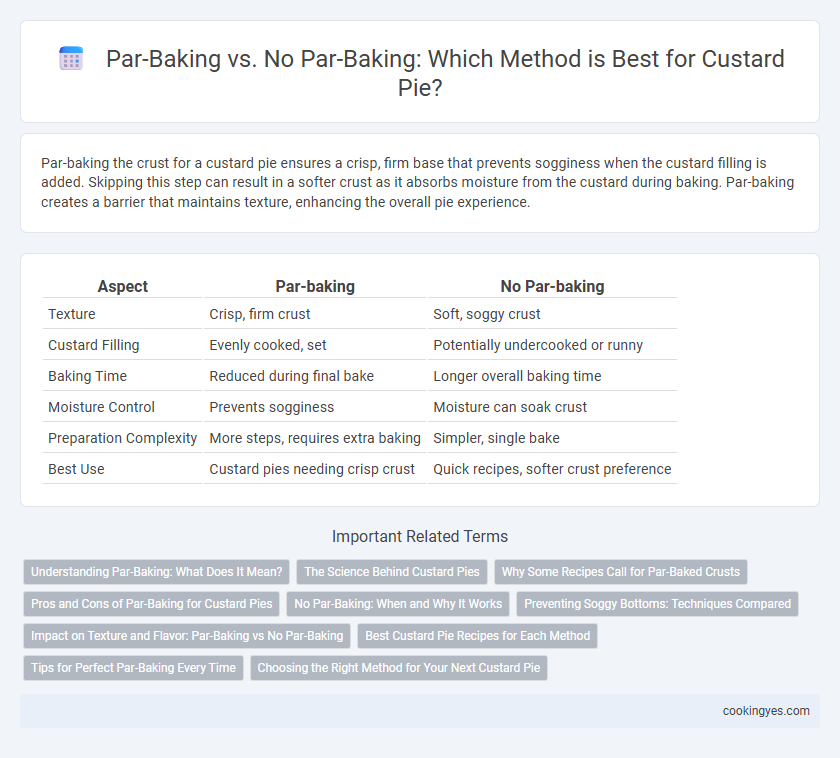Par-baking the crust for a custard pie ensures a crisp, firm base that prevents sogginess when the custard filling is added. Skipping this step can result in a softer crust as it absorbs moisture from the custard during baking. Par-baking creates a barrier that maintains texture, enhancing the overall pie experience.
Table of Comparison
| Aspect | Par-baking | No Par-baking |
|---|---|---|
| Texture | Crisp, firm crust | Soft, soggy crust |
| Custard Filling | Evenly cooked, set | Potentially undercooked or runny |
| Baking Time | Reduced during final bake | Longer overall baking time |
| Moisture Control | Prevents sogginess | Moisture can soak crust |
| Preparation Complexity | More steps, requires extra baking | Simpler, single bake |
| Best Use | Custard pies needing crisp crust | Quick recipes, softer crust preference |
Understanding Par-Baking: What Does It Mean?
Par-baking refers to partially baking a pie crust before adding the custard filling, ensuring a crisp, fully cooked crust that prevents sogginess caused by the liquid filling. This technique is essential for custard pies, as it helps maintain the crust's texture and supports even baking of the delicate custard. Without par-baking, the crust may become undercooked or overly soft, compromising the pie's overall consistency and flavor.
The Science Behind Custard Pies
Par-baking the crust for custard pies creates a barrier that prevents the custard from seeping into the dough, ensuring a crisp, flaky texture by reducing sogginess caused by moisture absorption. Baking the crust without par-baking can result in a denser, less structurally stable base due to the high liquid content of custard filling interacting directly with the raw dough. The science behind custard pie texture relies on controlling heat transfer and moisture migration to achieve the ideal balance between a tender crust and a creamy filling.
Why Some Recipes Call for Par-Baked Crusts
Par-baking a pie crust for custard pies prevents sogginess by creating a barrier that keeps moisture from the filling from penetrating the dough. Recipes calling for par-baked crusts often require this step to ensure a crisp, fully cooked bottom and stable structure under the creamy custard. Skipping par-baking risks a doughy texture and potential collapse during baking, affecting both flavor and presentation.
Pros and Cons of Par-Baking for Custard Pies
Par-baking a custard pie crust provides a crisp, stable base that prevents sogginess by sealing the dough before adding the moist filling. However, it can cause the crust to overcook or brown too much, leading to a less tender texture. Skipping par-baking maintains a softer crust but risks a soggy bottom and a less defined edge.
No Par-Baking: When and Why It Works
No par-baking custard pies is ideal when the filling requires a fully baked, creamy texture that sets gently without a pre-cooked crust, ensuring a tender, flaky base absorbs moisture evenly. This method works best with high-moisture custard recipes where the crust finishes baking simultaneously with the filling, preventing sogginess and maintaining structural integrity. Avoiding par-baking saves time and preserves the delicate balance between crust and custard, especially in recipes with short baking durations at moderate temperatures.
Preventing Soggy Bottoms: Techniques Compared
Par-baking the crust for custard pies helps create a barrier that prevents custard from seeping into the dough, reducing sogginess and maintaining a crisp texture. Without par-baking, the crust often absorbs moisture from the filling, resulting in a soggy bottom that detracts from the pie's structural integrity. Techniques like blind baking with pie weights ensure even cooking and a firm base, while skipping par-baking requires careful filling composition to minimize excess liquid absorption.
Impact on Texture and Flavor: Par-Baking vs No Par-Baking
Par-baking a crust for custard pie creates a firmer, less soggy texture by partially cooking the dough before adding the filling, resulting in a crispier bottom layer that counters custard's moisture. In contrast, no par-baking yields a softer, more tender crust that absorbs custard liquids, often producing a chewier consistency with intensified buttery flavors. The decision between par-baking and skipping it significantly influences the pie's textural contrast and depth of flavor, with par-baking enhancing crispness and no par-baking promoting melding of custard and crust flavors.
Best Custard Pie Recipes for Each Method
Par-baking pie crusts for custard pies ensures a crisp, golden base that prevents sogginess, ideal for recipes with delicate custard fillings like classic pumpkin or sweet potato pies. No par-baking allows the custard to bake directly in the raw crust, resulting in a softer, more tender crust texture that complements creamier custards such as traditional custard or chess pies. Choosing between par-baking and no par-baking depends on the desired crust texture and custard consistency, with each method best suited to specific custard pie recipes.
Tips for Perfect Par-Baking Every Time
Ensure the pie crust is chilled thoroughly before par-baking to prevent shrinking and uneven baking. Use pie weights or dried beans to keep the crust flat and avoid puffing during the par-bake process. Bake at 375degF (190degC) until the edges are golden and the center is set but not browned, optimizing the crust's texture for smooth custard filling.
Choosing the Right Method for Your Next Custard Pie
Choosing between par-baking and no par-baking for custard pie depends on achieving the desired crust texture and custard consistency. Par-baking the crust for 10-15 minutes at 375degF prevents sogginess by creating a firmer barrier, ideal for custard pies with high moisture content. Skipping par-baking allows for a softer crust but may result in a less stable structure, so selecting the method based on your recipe's moisture level ensures the perfect custard pie outcome.
Par-baking vs no par-baking for custard pie Infographic

 cookingyes.com
cookingyes.com